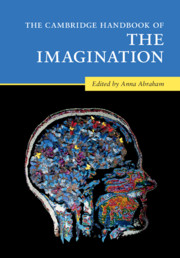Book contents
- The Cambridge Handbook of the Imagination
- The Cambridge Handbook of the Imagination
- Copyright page
- Dedication
- Contents
- Figures
- Contributors
- Acknowledgments
- 1 Surveying the Imagination Landscape
- Part I Theoretical Perspectives on the Imagination
- 2 The Evolution of a Human Imagination
- 3 Material Imagination: An Anthropological Perspective
- 4 The Archaeological Imagination
- 5 Philosophical Perspectives on Imagination in the Western Tradition
- 6 Imagination in Classical India: A Short Introduction
- 7 From Prediction to Imagination
- 8 Memory and Imagination: Perspectives on Constructive Episodic Simulation
- 9 Capturing the Imagination
- 10 A Sociocultural Perspective on Imagination
- 11 Artificial Intelligence and Imagination
- Part II Imagery-Based Forms of the Imagination
- Part III Intentionality-Based Forms of the Imagination
- Part IV Novel Combinatorial Forms of the Imagination
- Part V Phenomenology-Based Forms of the Imagination
- Part VI Altered States of the Imagination
- Name Index
- Subject Index
- References
4 - The Archaeological Imagination
from Part I - Theoretical Perspectives on the Imagination
Published online by Cambridge University Press: 26 May 2020
- The Cambridge Handbook of the Imagination
- The Cambridge Handbook of the Imagination
- Copyright page
- Dedication
- Contents
- Figures
- Contributors
- Acknowledgments
- 1 Surveying the Imagination Landscape
- Part I Theoretical Perspectives on the Imagination
- 2 The Evolution of a Human Imagination
- 3 Material Imagination: An Anthropological Perspective
- 4 The Archaeological Imagination
- 5 Philosophical Perspectives on Imagination in the Western Tradition
- 6 Imagination in Classical India: A Short Introduction
- 7 From Prediction to Imagination
- 8 Memory and Imagination: Perspectives on Constructive Episodic Simulation
- 9 Capturing the Imagination
- 10 A Sociocultural Perspective on Imagination
- 11 Artificial Intelligence and Imagination
- Part II Imagery-Based Forms of the Imagination
- Part III Intentionality-Based Forms of the Imagination
- Part IV Novel Combinatorial Forms of the Imagination
- Part V Phenomenology-Based Forms of the Imagination
- Part VI Altered States of the Imagination
- Name Index
- Subject Index
- References
Summary
The archaeological imagination is defined as a creative capacity mobilized when we experience traces and vestiges of the past, when we encounter, gather, classify, conserve and restore, when we work with such remains, collections, archives to deliver narratives, reconstructions, accounts, explanations, or whatever. Examples are given and features described of such archaeological experiences that reach far beyond the academic discipline: the dynamics of working creatively with what remains. The roots of the archaeological imagination are traced in three phases from the seventeenth century: challenges to traditional relationships with the past associated with field science; the empirical accumulation of material remains of the past; the expansion of the heritage industry in post–1970s globalization. Encompassing wide cultural valency, the archaeological imagination is argued to be a key aspect, relating to temporality and materiality, of contemporary cultural agency: our imaginative capacity to work with what remains in building future worlds.
- Type
- Chapter
- Information
- The Cambridge Handbook of the Imagination , pp. 47 - 63Publisher: Cambridge University PressPrint publication year: 2020
References
- 2
- Cited by



